Excerpts from Jim Conrad's
Naturalist Newsletter
entry dated April 5, 2023, issued from near Tequisquiapan; elevation about 1,900m, (6200 ft), ~N20.57°, ~W99.89°; Querétaro state, MÉXICO
(~N20.55°, ~W99.89°)
OX BEETLE
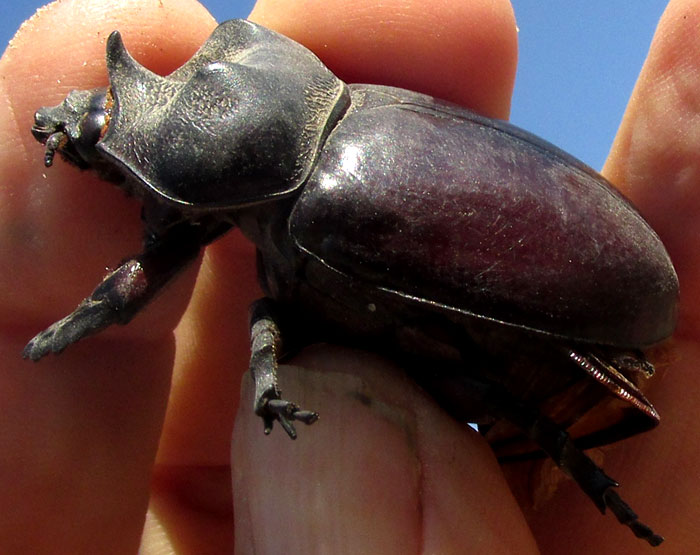
The above big beetle was found upside down, wiggling his legs skyward, on a winding dirt trail surrounded by overgrazed pastures and hacked-up scrub. From head tip to rear end, the beetle was 47mm long (1.6 inch).
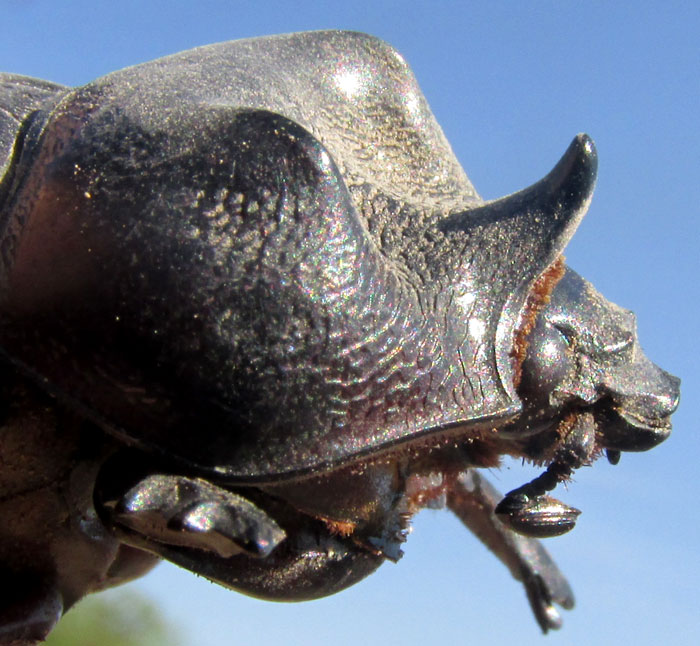
Besides the large size, the best field marks for this species are the three conspicuous protuberances -- a long pointed one up front and two ridged ones farther back -- on the pronotum. The pronotum is a plate-like structure mantling an insect's body section immediately behind the head, the thorax.
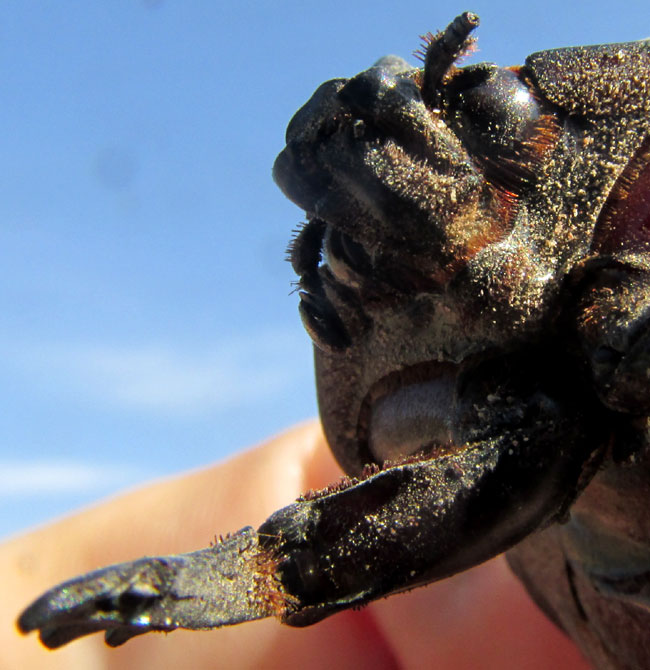
Above, the head is seen from below, an pointing at the lower, left corner is one of the front legs. Note that the leg's parts are somewhat flattened, like paddles. The head's jaws, or mandibles, supposedly appear below, but they're not apparent to me. The bristly antenna atop the picture consists of only the bottom segment, the rest being broken off.
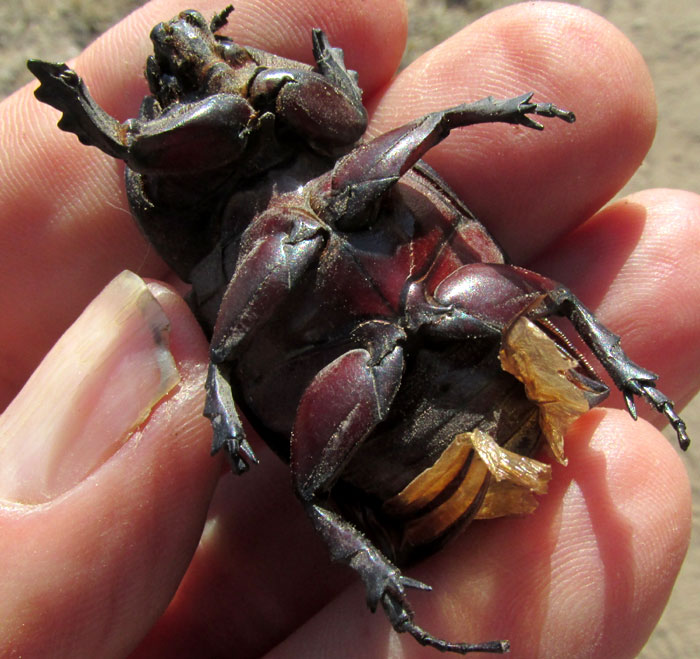
The bottom view shows certain leg segments also missing, especially the front ones, and the papery back wings extending from beneath the hardened front wings, or elytrons, are bent, crumpled and tattered. This beetle has seen rough times. Maybe his lying on his back with legs in the air was the last act of an old, worn-out individual.
With such distinctive features, it was easy to identify as the Ox Beetle, STRATEGUS ALOEUS. The various ox beetle species of the genus Strategus belong to the Rhinoceros Beetle Subfamily Dynastinae, of the Scarab Beetle Family, the Scarabaeidae.
I've been looking for an adult Ox Beetle because, as the entries following this one show, in Texas and the Yucatan we've found big grubs that most likely were Ox Beetle grubs. Strategus aleous occurs across the southern US south throughout Mexico, except the driest parts, through Central America, and here and there in South America, as shown on its GBIF occurrence map.
In Brett Ratcliffe's 1976 "A Rivision of the Genus Strategus (Coleoptera: Scarabaeidae)," it's seen that a number of Strategus species exist other than our aloeus. Most others are South American, Caribbean, or occurring in other parts of Mexico, and some look different from our beetle, but some similar other species may conceivably also occur here. Strategus aloeus is by far the most commonly occurring in Querétaro state, while I can't find other species documented here. Still, without looking at obscure items, such as genitalia, which require dissection, I can't be completely sure about our species.
Ratcliffe writes that Ox Beetle larvae such as those in the next sections feed on decayed wood, but apparently will feed on root material when necessary. Adult beetles, he says, have been found feeding on the roots of various palms and rotten wood, but that, despite mentioning that sometimes they burrow up through palm trunks into the heartwood, "... Strategus aloeus is rarely of economic significance to palm plantations." Currently the Wikipedia Strategus aloeus page says that "... adults feed on flowers and all sorts of fruit." Wikipedia's remarks are more often repeated on various Internet pages than Ratcliffe's. The widened legs seen in our third-from-top picture, tending somewhat toward legs of soil-tunneling Mole Crickets, suggest to me that Ratcliffe's revision with all its citations of documented observations is more to be believed.
Female Ox Beetles lack the two raised protuberances at the back of the thorax's pronotum, and her horn-like point is only slightly raised. The above pictures clearly indicate that our beetle is a male. A curious feature about horned species of the Ox Beetle genus Strategus is that they display two forms: a major and a minor. The major's horn is considerably longer than the minor's. However, Ratcliffe says that horn length is possibly the result of the nutritional history of the larvae, and that "There is no clear boundary separating the two forms of development and all gradations between the two extremes occur."
Because of their large size and heavy armature, adult Ox Beetles have few natural enemies, though sometimes they're trapped in large spider webs. The big larvae have been eaten by various human indigenous groups, are parasitized by intestinal worms, and sometimes die from pathogenic microbes.
from the October 5, 2014 Newsletter issued from the Frio Canyon Nature Education Center in the valley of the Dry Frio River in northern Uvalde County, southwestern Texas, on the southern border of the Edwards Plateau; elevation ~1750m (~5750 ft); N29.62°, W99.86°; USA
OX BEETLE GRUB
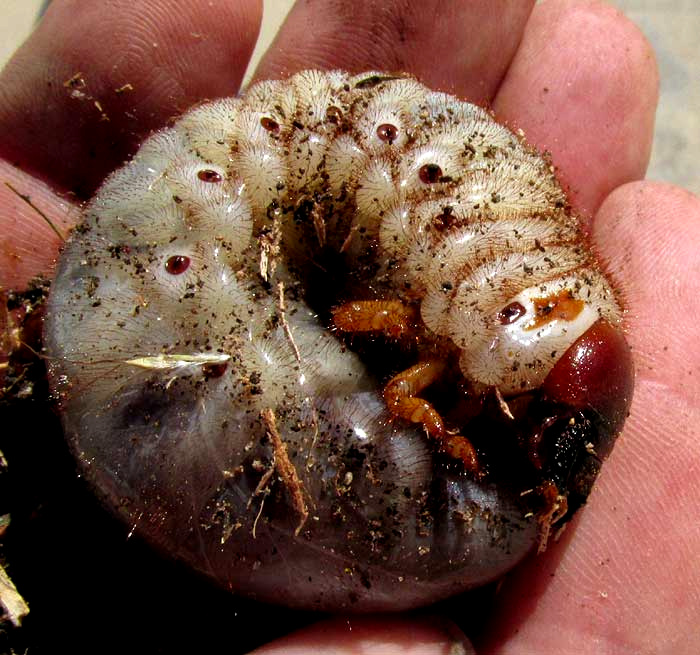
While moving a pile of Mesquite firewood, at the very bottom of the pile where the wood was decaying, crumbling and becoming part of the soil, two enormous grubs turned up. That's one in my hand above.
The curled-up grub was about two inches across (5cm). If I'd straightened him out, surely he'd have extended to 4 inches (10cm). Afraid that unbending him might cause injury, I only made a half-hearted effort at it, but even that caused him to poop an incredible amount of wet, reddish wood fiber onto my hand, revealing that this grub was an important agent for converting decaying wood to an organic form more accessible for other organisms.
A view of the grub's head, showing jagged-edged mandibles that could pinch a little, but not enough to hurt, is shown
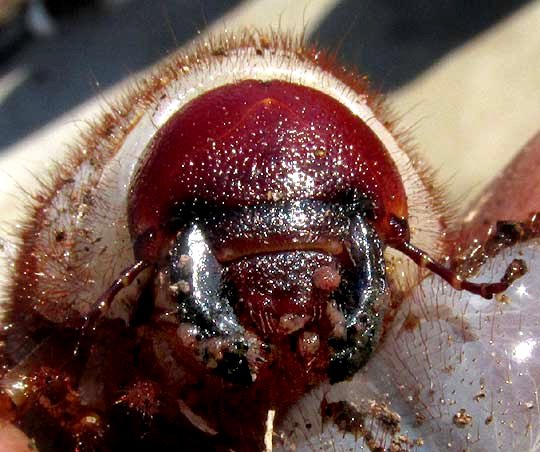
A view better showing the grub's unusually scalloped side-flesh, with amber-colored spots surrounding the breathing holes, or spiracles, along its sides, and a characteristic amber blotch on the white skin just behind the head appears below:
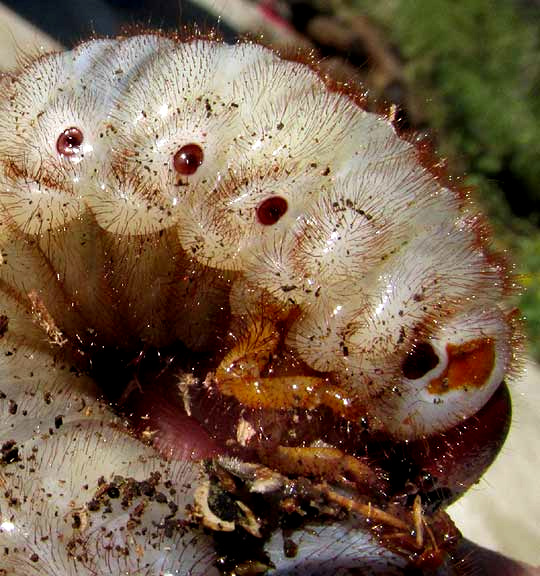
Volunteer identifier Bea in Ontario has been extra busy with her real work this week so I made a stab at identifying the grub myself. Lacking Bea's insights into the many beetle families -- and grubs like this are produced by beetles -- I sort of "cheated" with the very non-technical-but-sometimes-effective approach of doing a Google image search on the keywords "grub huge wood," and by golly the first thumbnail on the page that resulted illustrated a grub just like ours.
That picture was on Texas bug-maven "Valerie's" AustinBug.Com website, dedicated to bugs of the Austin, Texas area, and the grub was identified as an Ox Beetle, sometimes also called Elephant Beetle or Eastern Hercules Beetle; it's STRATEGUS ALOEUS. Valerie writes that "We find these huge creatures in the lower parts of our compost bins, where they feed on decaying wood." She also says that the grubs take at least two years to mature, "as wood is not a particularly nutritious diet."
The adult Ox Beetles into which these grubs metamorphose are regarded as the largest beetle species in the US, reaching about 2½ inches long (63mm). They're very closely related to Rhinoceros Beetles, the major form of the male adult possessing a long, slender "horn" between and just below an additional two long, wedge-shaped projections.
Ox Beetles range across the US southernmost states from Florida to Arizona. Mostly they're tropical insects, though, since from the southern US their distribution continues on south through all of Mexico, the Caribbean area and Central America, into South America, down to Brazil.
In fact, when I began looking for other pictures of Ox Beetle grubs, one of the first to turn up was one my own! In 2010 we profiled this same species at Hacienda Chichen in the central Yucatan {see below, where we use the common name Rhinoceros beetle}. It had never occurred to me that the same species might occur here.
from the December 5, 2010 Newsletter issued from Hacienda Chichen Resort beside Chichén Itzá Ruins, central Yucatán, MÉXICO
A BIG GRUB
Once again Santos arrived at my door smiling saying, "I think you'd like to see this... " He'd been digging up a flowerbed and had unearthed the item shown below:
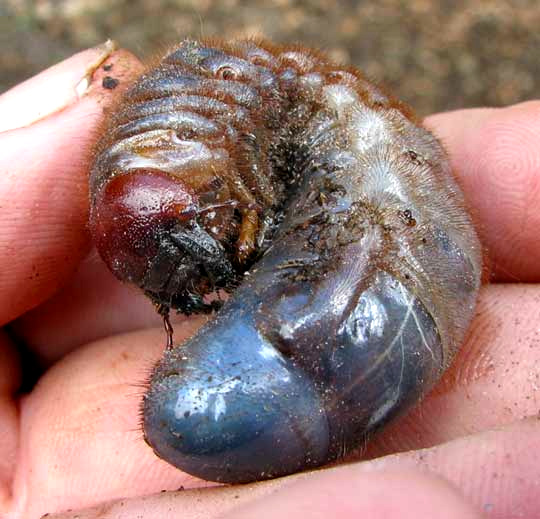
If you compare the big grub with the width of my fingers you'll see that this is a pretty big grub -- the largest I've ever seen. Volunteer insect identifier Bea in Ontario did her best on it. She wrote:
I think we can ID it as a ... Scarab beetle larva. But there are many different tribes under Scarab Beetle. The Rhinoceros Beetle subfamily Dynastinae includes the very large Hercules, Ox, and Rhinoceros beetles, but there are over 300 known species of rhino beetle. Thing is, the larvae mostly all look alike! So, I don't think we can really confirm the species unless you keep it until it turns into an adult, but the Rhino Beetle's larval stage can be several years long. The larvae eat rotting wood. Was yours found in rotting wood?
Yes, the soil Santos had been digging in was full of rotting wood. After Googling awhile and comparing lots of pictures, I decided that Bea probably was right as usual, that it was in the Rhinoceros Beetle subfamily. Moreover, of the many species in that subfamily there's one particularly common species "found in every Mexican state," whose grub pictures look just like ours.
That's the Rhinoceros Beetle, STRATEGUS ALOEUS, distributed from Arizona to Georgia and Puerto Rico south to Brazil -- just about all the Americas' hot lowlands. However, there are 31 species of Strategus beetle, so calling it the Rhinoceros Beetle is just an educated guess.
Adult Rhinoceros Beetles are so large, and the males are so impressive with their big "horns," that they're often sold in the pet trade.